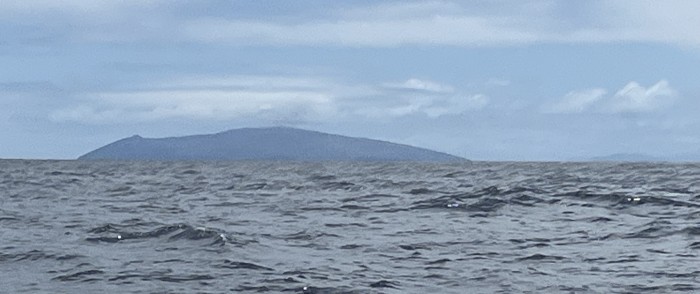Where the Tragedy of the Commons Meets the Beak of the Finch
11 July 2022
by Karl Coplan

We rose at six in light rain to get ready to sail to Santa Cruz, started the engine, and hauled in the anchor chain. By six thirty, we were on our way through the lava reefs in the approach to the harbor. Nice sailing today - close reaching in a ten to twelve knot breeze that made for easy progress against the current. It is a forty mile backtrack to the east - but our agent told us we has to visit Santa Cruz last for provisioning and outbound clearance.
Along the way, as we passed south and east of Los Quattros Hermanos rocks (each with its own orographic cloud), Isla Pinzon came into view in the mists.
The rest of this post is a bit academic and policy oriented, so skip it if you are not interested!
Isla Pinzon means finch island, and the fate of the cactus finches on Isla Pinzon comes up as a cautionary tale in the last chapter of The Beak of the Finch, Jonathan Weiner’s captivating account of biologists studying evolutionary adaptation in real time among the isolated finch populations on small isLands in the Galapagos.
Now, those of us who have taught environmental law and policy have used a famous essay by ecologist Garrett Hardin, called “The Tragedy of the Commons,” as a teaching tool for many decades. Hardin uses the parable of shared grazing lands to illustrate the paradox of the free market economic principle of individual wealth maximization. Each herder has the incentive to add more animals to their herd to maximize their own wealth, until the common pasture is overgrazed and all the herds die, destroying everyone’s wealth.
Although Hardin’s parable is meant to illustrate the collectively self-destructive potential of economically “rational” action by individuals, the same paradox shows up on Isla Pinzon as pure instinct in The Beak of the Finch. Darwin himself was impressed by the wide variety of species of finches in the Galapagos and how the beak of each species was adapted for a particular food. Cactus finches are the only finches that can open the cactus seeds, which is their primary source of food. But they also drink cactus nectar. Some cactus finches learned that if they reached the cactus flowers earlier in the day, before the flowers opened, they could drink more nectar and grow larger. But this nectar hogging came at a price - the early birds broke the stigma of the unopened flowers to get at the nectar, preventing the cactus from blooming and propagating ever again. But the early birds grew larger and sexier (umh, “had better reproductive success”)’, so cactus killing early-birdism got to be a generational norm.
The Beak of the Finch has this passage:
But when the needs of the individual clash with the needs of the flock, it is the individual that triumphs, even if this private success leads to the downfall of the flock. . . . Cactus finches did go extinct earlier in this century on the uninhabited island of Pinzon, whose name is Spanish for finch.
So wealth maximizing individualism may not be such a great example of a perfectly rational “homo economicus” of economic theory, but raw uncontrolled and ultimately self destructive instinct. The rational response, proposed by Garret Hardin, is for rational self preservation to lead to collective self restraint and regulation of the commons to preserve it for the common good.
This parable works for everything from federal grazing lands management to fishing quotas to water pollution control to, yes, even climate change. Are we rational beings capable of avoiding the destruction of the the systems that keep us alive? Or, like the cactus finches of Isla Pinzon, will we allow rugged individual early birds to snap the last cactus flower stigma and greedily suck down the nectar?



Comments